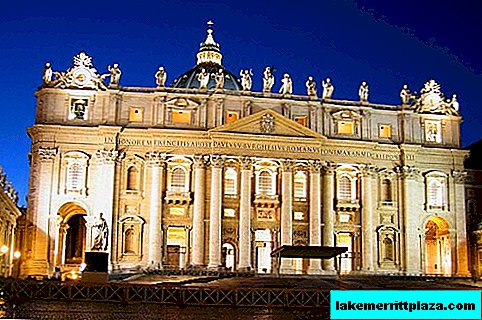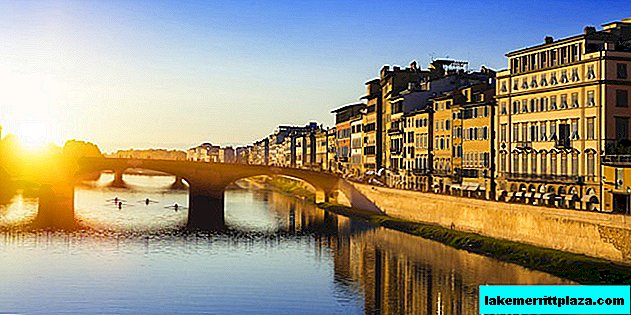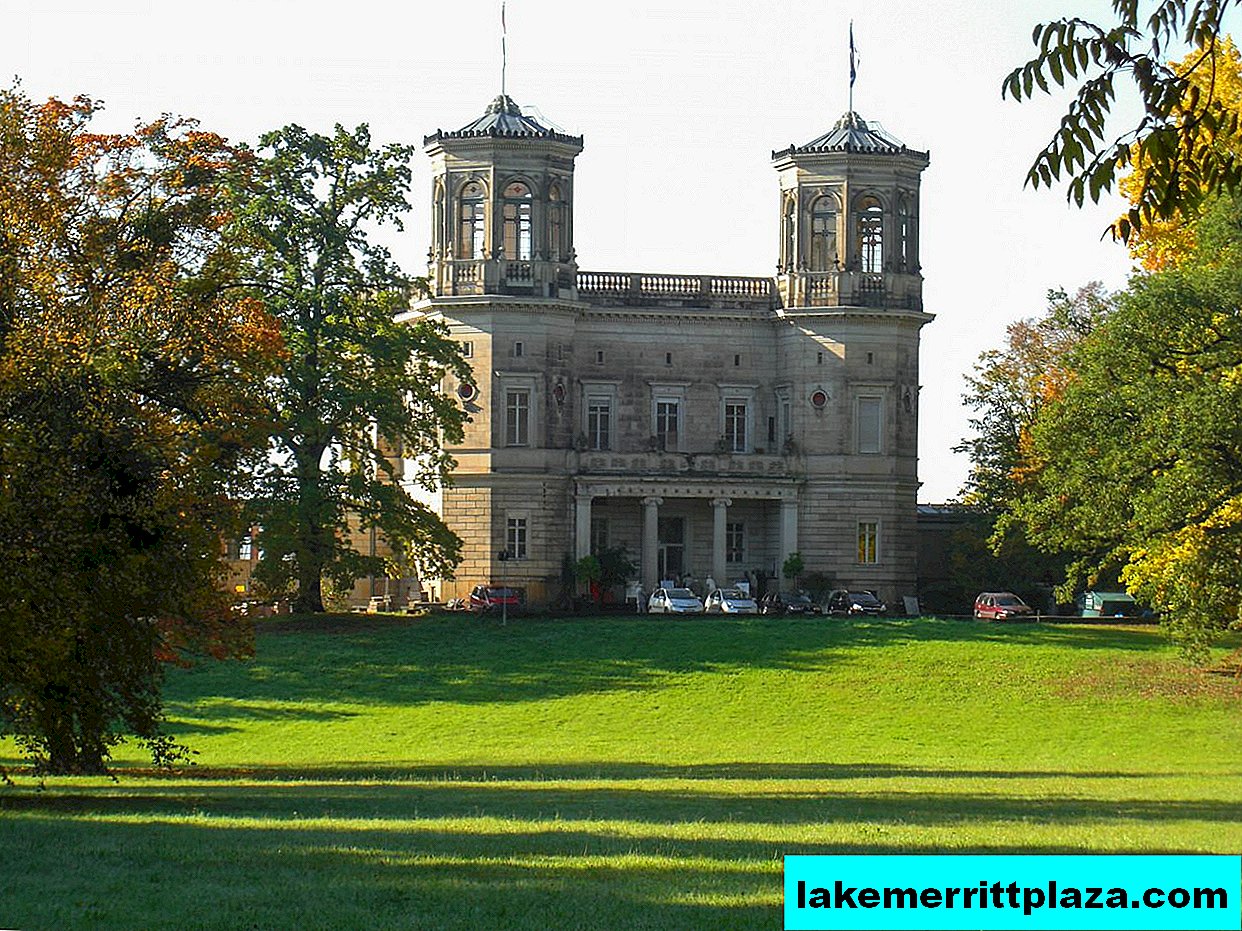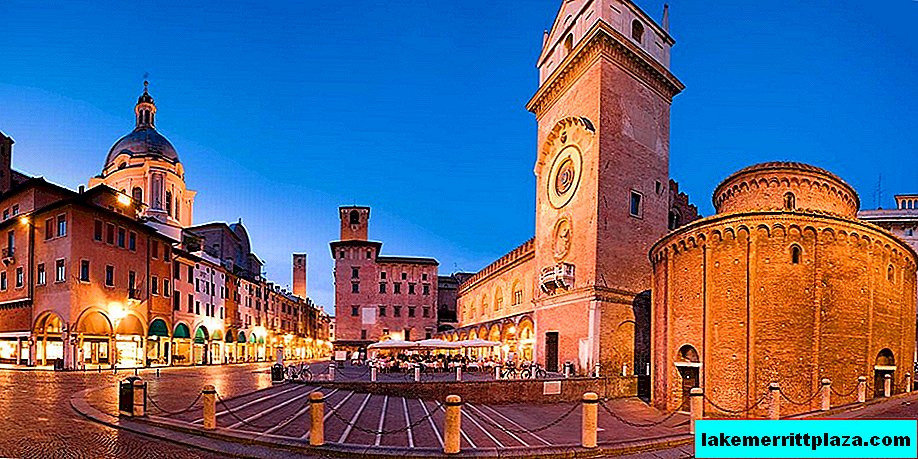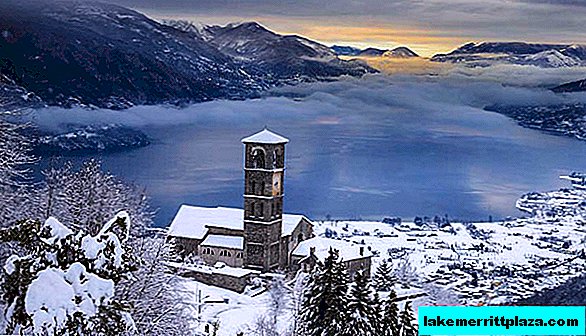There are a great many monuments and fountains in Cologne. The most famous of them are located in a relatively small area of the Old Town near the main city attraction - Cologne Cathedral.

German sketches
German sketches. Part I
German sketches. Part II
German sketches. Part III
German sketches. Part iv
German sketches. Part v
German sketches
Part VI. Monuments and fountains of Cologne
There are a great many monuments and fountains in Cologne, which is not surprising for a huge city with a million inhabitants. However, the most famous of them are located in a relatively small area of the Old City and you can see them during a short walk without moving too far from the main city attraction - Cologne Cathedral.
Well, right from the cathedral and begin. And we will start with monuments to the most famous personalities - kings and emperors. The cathedral stands next to the Hohenzollern railway bridge thrown across the Rhine. The bridge was named after the dynasty that ruled in Brandenburg from the 15th century, and later in Prussia, annexed to Brandenburg. Monuments were erected on both sides of the bridge to the last four rulers of this dynasty - Frederick Wilhelm IV, Wilhelm I, Frederick III and Wilhelm II.

Monument to Kaiser Wilhelm II
On the left bank of the Rhine, near the cathedral, right next to the bridge is a monument to the last German monarch - Kaiser Wilhelm II. Kaiser was a close relative of the last Russian emperor Nicholas II. Regal relatives turned to each other easily - "Nicky's cousin" and "Willy's cousin", although in the literal sense of the word they were not cousins. These appeals were used by them, obviously, because Nicholas was married to William's cousin - Princess Alice of Hesse-Darmstadt (in Orthodoxy, Alexandra Fedorovna). Although William, like Nicholas, lost his throne as a result of the revolution, his demise was not as tragic as that of "cousin Nicky." He fled from the revolution to the Netherlands, where he lived until his natural death in 1941.

Monument to Kaiser Wilhelm II
Not far from another bridge across the Rhine - Deutschebrücke - on Heumarkt there is a monument to another Hohenzollern - King of Prussia Friedrich Wilhelm III.

Monument to King of Prussia Frederick William III
The ruler he was mediocre, as they say, there were not enough stars from the sky. However, during his reign Prussia, thanks to her participation in the anti-Napoleonic coalition, after defeating Napoleon annexed quite vast territories in the Rhine region, including Westphalia and Cologne. Even Friedrich Wilhelm III, first of all, is interesting to us because under him the Prussian Hohenzollerns were directly related to the Russian ruling house of the Romanovs.

Monument to King of Prussia Frederick William III
The daughter of Friedrich Wilhelm III Charlotte married the brother of the Russian Emperor Grand Duke Nikolai Pavlovich, who later became Emperor Nicholas I. Thus, Friedrich Wilhelm III was the great-great-grandfather mentioned above to Wilhelm II, and Nicholas II was the great-great-grandfather, which did not prevent the “cousins” in the first world war clash with each other not for life, but for death. But here, to paraphrase the famous saying, "nothing personal, only politics."
I think that quite a lot has been said about Russian-Prussian monarchist-dynastic relations. Let's move on to more mundane topics. For example, to the Cologne fountains. We were in Germany in the first half of March. Due to the early spring, the fountains did not work yet, however, this did not make their inspection less interesting.
Some Cologne fountains combine the functions of both fountains and monuments. Such is the monument to General Johann von Werth, already mentioned by me in the previous part of the report, standing on Alter Markt square next to the old city hall.

Monument to General Jan von Werth
In Cologne, this illustrious general is better known by the name of Jan von Werth. Walking along the Rhine promenade, we saw a river boat standing at the pier, bearing the name of this historical figure quite popular in Cologne.

River boat "Jan von Verth"
It’s quite difficult to explain von Werth’s popularity among Cologne, knowing that the general was not a native of Cologne and that his activities in the military aren’t connected with the history of Cologne. True, Johann von Werth was born in Westphalia and, obviously, this circumstance allows the inhabitants of Cologne to consider him their countryman. What did General von Werth become famous for?
He was born at the end of the XVI century in a family of small nobles and was the eldest of eight children. In those ancient times, small nobles lived no better than commoners, so Johann left his family early and entered the military service as an ordinary soldier. For some time he served in the Spanish army, who fought in the Netherlands adjacent to Westphalia. Then he went to the service of the Elector of Bavaria. At that time, the Thirty Years War, in which the Bavarian troops were the main force of the Catholic League, opposing the Protestant states of Northern Europe, was in full swing in Germany at that time, which was in full swing. Von Werth, who fought in the cavalry, thanks to his outstanding abilities, made a brilliant military career, rose through the ranks to the rank of general and, in addition to this, received the baronial title.

Monument to General Jan von Werth
It is known that General von Werth was a supremely man of honor. In one of the battles, he was captured and was transferred to France, which fought on the side of the Protestants. The French with von Wert had their own scores. The fact is that he was a master of deep cavalry raids on enemy rear. He made several similar raids on the territory of France, after which for a long time the French mothers frightened their naughty children with the “terrible Jean de Werth”. So, the French offered von Werth to give him relative freedom in exchange for an honest word that he would not try to escape from captivity. Von Werth gave such a word and for four years spent in captivity, did not make any attempt to escape. In the end, the Bavarians exchanged him for one of the Protestant military leaders who were captured by them, and von Wert continued to fight.
A year before the end of the Thirty Years' War, Bavaria entered into a separate armistice with the Protestant League and the restless von Werth, who, as you can see, who had not yet been at war for his nearly forty-year military career, went to serve in the Austrian Habsburgs. Emperor Ferdinand III made him commander of the entire imperial cavalry, and at the end of the war, he granted von Werth a large estate in Bohemia and the count's title with the highest permission for all his services. Six years after this, General Johann von Woerth rested in his Bohemian estate. Whether he visited Cologne after the war or not, documentary evidence has not been preserved.
The story of Johann von Werth is not at all unique. There were other talented generals in Europe who made a career from the bottom, but for some reason it was he who became the hero of one of Cologne's most romantic city legends.

Monument to General Jan von Werth
The photo shows that the fountain monument is a high pedestal, on top of which there is a sculpture of a full-length standing and leaning on a sword General Johann von Werth. At the foot of the monument is a figure of a seated girl. Looking at her, you immediately realize that it was not without a romantic love story.
Indeed, the legend says that once upon a time in the glorious city of Cologne there lived a poor young man named Jan Werth, who was a farm laborer by a wealthy city dweller who sold herbs, vegetables and fruits at the market. And this merchant-greengrocer had a daughter, Greta, one of the first beauties of the city. It is easy to guess that Jan fell in love with his master's daughter without a memory. Of course, if he had a muscular torso, a passionate look, a white-toothed smile and brutal unshaven, he could count on the favor of the beauty. But alas, most likely, he was a crude bumpkin who could not connect a couple of words. Let's be objective, his chances were zero. Moreover, the subject of his passion, possessing a model appearance and, as is often the case in such cases, exorbitant conceit, did not possess such qualities as meekness and kindness. Greta, noticing Jan’s love, did not miss a single opportunity to mock the poor guy and make him a laughing stock in front of others. She herself, along with her dad, hoped to make a more profitable party and marry a man, though not more handsome, but much richer than a simple farm laborer. Legend has it that it was unhappy love that drove Jan Werth to leave Cologne and join the soldiers.
Once in the army, Ian realized that his true calling in life was not to drag heavy baskets of turnips and apples to the market, but to rush towards a danger on a war horse, famously shooting pistols and chopping a broadsword of enemy soldiers. In addition, over time, he showed commanding abilities and, step by step along the career ladder, for forty years of service he went from a rank-and-file soldier to general. Along with the ranks, fame and honors, he earned a noble title and the noble prefix "background" was added to his surname.
Legend has it that at the end of the war, the army in which Jan von Werth was stationed was preparing for a decisive battle near Cologne. Taking the opportunity, the general decided to visit his hometown in which his youth passed. Riding past the city market, he drew attention to the merchant, whose facial features seemed familiar to him. As befits in romantic stories, their eyes met and they immediately recognized each other. Of course, what doubt could be, it was Greta. She grew old and little was left of her former beauty, but memories of those times when she was young and beautiful immediately flared up in Jan's memory. They got into a conversation and Jan found out that Greta never got married. Fate punished her for pride - the rich bridegroom never turned up and she was like a market trader, so she remained. “Ah, Greta,” said Jan, “if you would marry me then, you could share with me everything that I have now. You would be a noble and rich lady and beloved wife.” “Ah, Jan,” Greta answered him, “if you would have married me then you would now be standing next to me at the counter and selling apples.” We give her credit, the legendary Greta was not a stupid woman.
Not far from the monument to General Jan von Werth and the old city hall is the Carnival Fountain.

Carnival Fountain in Cologne
I already said in the previous part of the report that we were in Cologne immediately after the end of the annual Cologne Carnival. Catholics and Protestants, by analogy with the Orthodox carnival, carnivals are held in the week preceding the beginning of Lent. Just like the days of Shrovetide week, each day of the carnival has its own name. True, in different countries, and even in different cities of one country, a carnival can have its own local characteristics. So, in Cologne, the first day of the carnival is called Babi Thursday. On this day at exactly 11 hours 11 minutes all the power in the city passes into the hands of women. They, dressed in carnival costumes and armed with scissors, go hunting. They hunt neither rabbits nor partridges, but men. Men are forbidden to go out without ties this day. The main goal of women is to cut off a part of a tie from a gaping man. Hunters pin the cut off parts of ties to their carnival outfits, just as the Indians adorned themselves with scalps of enemies. According to the custom that has developed over the centuries, a man who has a tie cut off is obliged to fulfill any desire of the woman who produced this “circumcision”. Even the most obscene. Therefore, Babi Thursday has a second name - Day of Libertines.
One of the scenes of Babyn Thursday is represented by the Carnival Fountain. The sculptural composition of the fountain consists of images of dancing couples. These couples look quite erotic.

Fragment of the Carnival Fountain
In addition, the figure of Amur on a column towering in the middle of the fountain does not allow one to doubt that, obviously, the matter will not be limited to dancing. Cologne jokes that on Babi Thursday some especially temperamental and loving men leave the house, wearing several ties at once. As they say, to walk, so to walk.
Of course, the most famous fountain in Cologne is the Dwarf Fountain, located near the Cologne Cathedral. It was created on the basis of the legend of the gnomes-brownies, who at night helped the residents of the city do their homework. They did it so quietly that they were never seen or heard. The curious wife of a tailor wanted to see them at all costs. In the evening, on the steps of the stairs leading to the basement, she scattered dry peas. The gnomes who went to work slipped on peas and with a roar head over heels rolled down the stairs. The mistress of the house immediately appeared with a lantern and made out unhappy frightened babies. This scene was captured by the author of the Dwarf fountain.

Dwarf Fountain in Cologne
The stupid woman satisfied her curiosity, and the gnomes were offended and left the city forever. I took the photo of the fountain from the Internet, because we ourselves did not take pictures of the fountain for the reason that I described in detail in the previous part of the report - the day before our arrival the annual Cologne Carnival ended and the entire foot of the fountain was littered with trash left after it.
Many monuments were built by the inhabitants of Cologne to their fellow citizens who distinguished themselves with certain good deeds. For example, the Osterman Fountain was built in honor of the author and singer of songs Willy Osterman.

Osterman Fountain in Cologne
His most important hits "Longing for Cologne" and "Once Upon a Time on the Rhine" are known to every individual. And in all, Osterman wrote over a hundred songs. In the composition of the fountain there are characters of the most popular of them.

Osterman Fountain in Cologne
And here is Willy Osterman himself.

Bas-relief of Willy Osterman
Met on the route of our walk and a monument to another poet and musician - pianist Jupp Schmitz, who was a performer of funny carnival hits. On the monument, he is depicted in a clown carnival cap.

Monument to Jupp Schmitz
At the end of the artistic theme, I’ll also say that in Cologne there is a monument to the comedian’s favorite, comedian Willy Millovich. The sculptor portrayed the actor sitting on a bench. The second half of the bench is free, anyone can sit and take a picture there. We did not see this monument, therefore we did not photograph it.
But we caught sight of a monument to another comedian - the Archbishop of Cologne, Cardinal Joseph Frings.

Monument to Cardinal Joseph Frings
For the thousand two hundred years of the existence of the archbishopric of Cologne, the archbishops were darkness and darkness, but only Joseph Frings was awarded the title of honorary citizen of the city. According to contemporaries, His Grace was not only a highly educated person and a brilliant preacher. In addition to these wonderful qualities, the holy father had an inexhaustible sense of humor.
In addition to the monumental buildings erected in honor of individuals, in Cologne there are monuments and fountains dedicated to some social groups of the urban population. One of them is the Fish Market fountain located on Fishmarkt Square next to St. Martin's Church.

Fish Trading Fountain in Cologne
And in Cologne there is a monument to women of all nationalities and all faiths who have ever lived in Cologne since its foundation.

Monument to the women of Cologne
I’ll talk about some of these women.
It is known that in early Christian times, Saint Ursula lived in the city for some time, who in these parts received a martyr's death at the hands of the Gentiles. Tradition says that she was killed for refusing to become the wife of the leader of the wild and ferocious Huns, who in those ancient times were considered the enemies of all progressive mankind. Well, they behaved accordingly, committing all sorts of atrocities and indecency in the vastness of Europe.
And in Cologne, in the first years after its founding, there were two women who, although they did not belong to the number of bloodthirsty Huns, were, however, more likely not direct, but indirect, to commit terrible crimes. And one of these women Cologne owes its name. Are you already intrigued?
These lovely ladies went down in history under the names Agrippina the Elder and Agrippina the Younger. They were ancient Romans and had each other mother and daughter. This story is quite long, but very entertaining, and it is worth telling.
It all started with the fact that in the place where Cologne is now located, the father of Agrippina the Elder - the Roman commander Marc Vipsanius Agrippa more than 2,000 years ago, laid down the fortified military camp Oppidum Ubiorum. At the time, the border between the Roman state and the territory inhabited by warlike Germanic tribes passed along the Rhine. According to the name of the ubiev-friendly tribe of Romans who migrated to the left bank of the Rhine, Mark Vipsanius Agrippa also called a new fortification.
By the way, Mark Agrippa was not only one of the best commanders of Rome, but also a personal friend and son-in-law of the first Roman emperor Octavian Augustus. It is not surprising, therefore, that his daughter Agrippina the Elder married the nephew of Emperor Germanicus. In order not to have any omissions, I will immediately explain: Germanicus had nothing to do with the ancient Germans, his parents simply called him that. So, Germanicus, just like father-in-law, was a military man and just like father-in-law was sent to the Oppidum Ubiorum in his time, to command the Roman legions on the Lower Rhine. Together with him, breaking the old custom, according to which the Roman wives were to wait at home for their husbands to return from military campaigns, Agrippina the Elder set off. On the banks of the Rhine, she, in addition to her two sons already existing, gave birth to four more children Germanicus. Among these four were a son with a long, long name Guy Julius Caesar Augustus Germanicus, better known in history nicknamed Caligula, and daughter Agrippina the Younger. Of these two cute children, over time, people grew up who possessed all the signs of moral monsters.
Caligula, who by the standards of that time was a pretty decent young man, becoming an emperor, suddenly turned into a crazy pervert. I will not give here a list of all his crimes and extravagant eccentricities, but I recall that it was he who made his horse a member of the Roman Senate and that he said about his subjects: "Let them hate, if only they were afraid." During his short reign, Caligula managed to shed a sea of blood, and was killed by the conspirators.
After that, his uncle Claudius, who had previously been a scientist and was very far from politics, was proclaimed emperor. However, Claudius became a capable ruler and gained love and popularity among the citizens of Rome. The only thing fatally unlucky for him was his wives. His last wife was his own niece, the sister of Caligula Agrippina the Younger, who, possessing exorbitant love of power, with the help of sophisticated intrigues, managed to marry her own uncle. However, we must pay tribute to her, becoming the wife of the emperor, she did not forget about her small homeland. The Oppidum Ubiorum was renamed the Colony of Claudia Ara Agripinensium, which from Latin translates roughly as "Colony of Claudius and the Altar of Agrippintsev." The status of the colony transferred the settlement to the rank of an imperial city, introduced Roman law on its territory, and gave the rights of Roman citizens to all its inhabitants. Gradually, the long name was reduced to one word Colony, and then in the local dialect it completely transformed into Cologne. The “godmother” of Cologne, if you can call the pagan Agrippina, started well, but ended badly. Even before she became the wife of the emperor, one of the ancient Roman psychics predicted to her that her son would reign, but would kill his mother. “Let him kill, if only he will reign,” this terrible woman answered the predictor. Taking advantage of the fact that Claudius did not have sons, Agrippina persuaded him to adopt her son from Nero's first marriage and declare him his successor. The weak-willed Claudius succumbed to persuasion, fulfilled the request of his wife, and immediately after that he was poisoned by mushrooms, which he loved very much. The emperor was Nero, whose reign was no less terrible than the reign of Caligula. And one of his crimes was the murder of his mother, who simply frustrated him with constant interference in state affairs. The prediction came true.
Such stories can plunge anyone into depression and depression, so it is absolutely necessary to change the subject and talk about something easy, fun and cheerful. Among the Cologne monuments and fountains, these criteria are most closely associated with the sculptures of two characters of urban folklore - Tunnes and Shell.

Tunnes and Shell
The inhabitants of Cologne composed many stories and jokes about these two characters. Tunnes is a squat and stocky peasant with the physiognomy of a village simpleton.

Tunnes - the embodiment of innocence
Shell is tall and slender, "like a London dandy dressed," cunning and somewhat arrogant.

Shell - the embodiment of cunning
It is believed that in Cologne, the traits of the characters of both are combined, despite their completely obvious inconsistency.
Although these two sculptures are not in open space, it is quite easy to find them. On the back side of St. Martin's Church is a large courtyard formed by several buildings. After going around the church and hitting this courtyard, carefully examine it. In one of the corners of the courtyard, there are figures of Tunnes and Shell. Stepping closer, you will see that the noses and feet of these incarnations of Cologne character are polished to a shine. They were polished during a thousand-fold repetition of the ritual, the observance of which guarantees the fulfillment of any desire. This ritual is very simple. You need to stand with one foot on the foot of Tunnes, with the other foot on the foot of Shell, with one hand hold on the potato nose of Tunnes, with the other hand - at the outstretched hand of Shell.
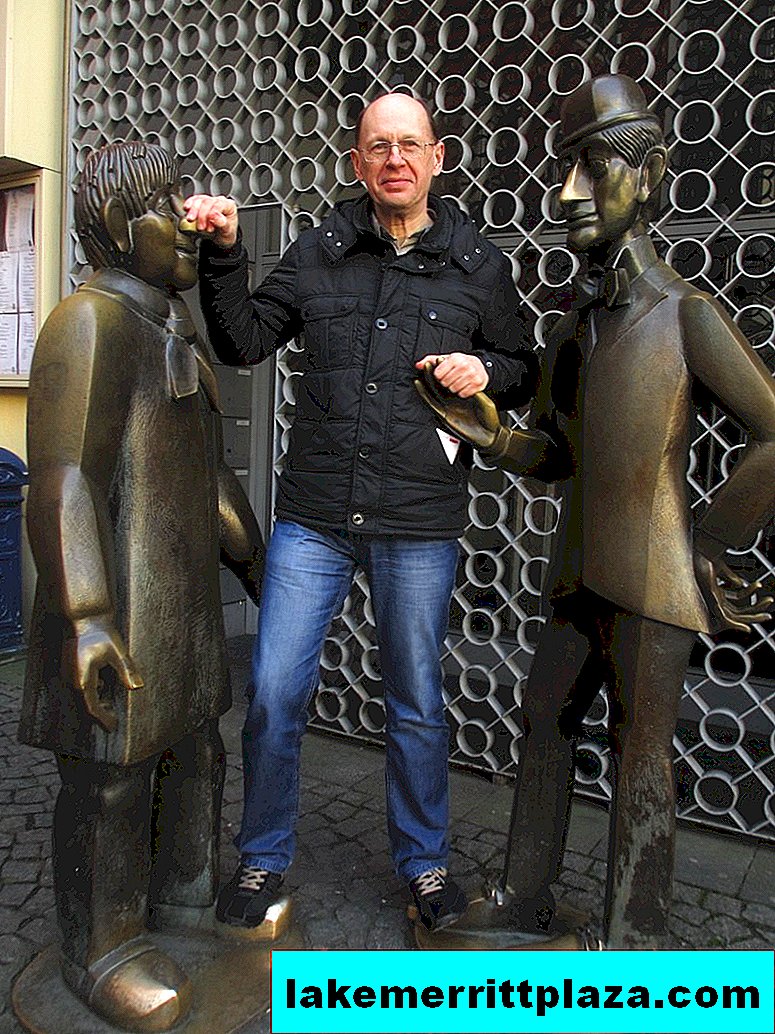
Do it and you will be happy
After that, it remains to make a wish and have patience to wait until it is fulfilled.
On this major note, I end the story of Cologne. In the next part of the report I will tell you about a city as ancient as Cologne and just like Cologne, which lies on the banks of the Rhine. The conversation will be about Koblenz. To be continued.
German sketches. Part VII
German sketches. Part VIII
German sketches. Part IX
German sketches. Part x

